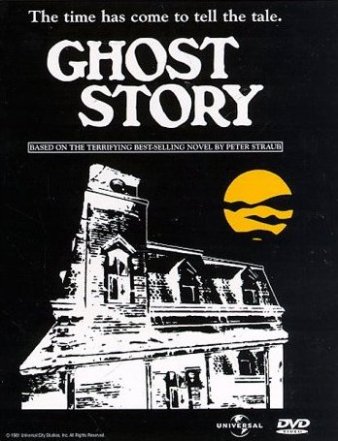Grant Davies takes a look at the Saturn Award winning Ghost Story
Four elderly gentlemen, members of ‘The Chowder Society’ hold a tradition of sitting around a roaring fire telling scary stories over a couple of glasses of brandy. Our aging protagonists are 2 lawyers, the town physician and lastly, the town Mayor; all upstanding and highly-respected members of the small community. More recently, these men have been plagued by horrific dreams and phantasmal apparitions to do with a young woman – the beautiful Alice Krige in a very strange role – from their past.
Truly, it must be said that the players in “Ghost Story” are screen legends. John Houseman and Fred Astaire are the lawyers; Douglas Fairbanks Jnr. is the Mayor and Melvyn Douglas particularly stands-out as Dr Jeffrey, the weakest-link both physically and emotionally in the group. Indeed, some would argue that “Ghost Story” is simply worth watching for the final screen appearances of Astaire, Douglas and Fairbanks Jnr alone. It’s an indulgent pleasure to watch these great actors bounce off with another, each gradually losing his mind to the guilt of a terrible and shared deed long-forgotten. Craig Wasson is the good doctor’s surviving son whose task it is to untangle the past and avoid the catastrophic end these men think is ominously inevitable.
The film runs very much like an actual ghost story; the scripted dialogue is direct and much of the movie takes place in flashback. The setting of the New England winter serves as an excellent backdrop for some consummate Jack Cardiff cinematography of a snow-clad town, its haunted mansions and their shuffling elderly occupants.
Nevertheless, at times the movie is a little docile and it’s clearly a gentle – albeit haunting – tale. Maybe this is the unintended impact of some rather plodding direction from John Irvin (a man incidentally most-noted for war movies like “Dogs of War” (1980) and “Hamburger Hill” (1987)). The disquieting musical accompaniment by Philip Sarde provides the most cogent attack on the audience’s sense of ease and apart from a couple of cheap-shock moments (most of which involve the rotten face of a long dead woman), there isn’t too much to make anyone jump out of their seat. Moreover, Dick Smith’s visual effects are understandably dated but if you can look past that are still reasonably effective in places.
All this doesn’t mean the film isn’t frightening; it’s just that it’s more of a brooding fear than a hide-behind-the-sofa feeling.
A few conspicuous plot-holes puncture the film’s second half and the scenes set in the 1930s are just a tinge too garish for my liking. In fact, the concentration on the younger selves of ‘The Chowder Society’ is an inconsiderate distraction from the events of the present day – where the much stronger cast have a better grip of the script and its material.
The last sequence is almost vexing and sits quite flimsily in a piece which never quite reaches the revealing climax the audiences yearns for. On the other hand, the rest of “Ghost Story” is in many ways a bewitching, atmospheric and well-performed chiller.
NB: The film was adapted from an altogether more sprawling novel by Peter Straub.

